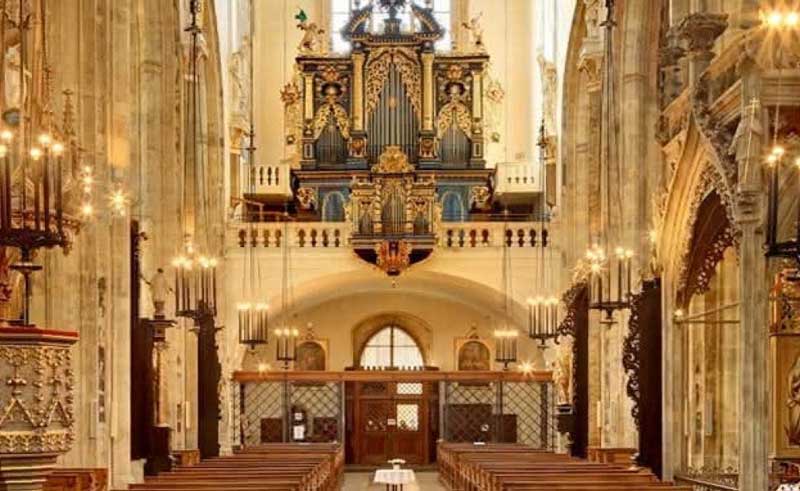
Standing proudly with its distinctive 262 feet (80 m) tall twin Gothic spires, the Church of Our Lady before Tyn is the largest and most beautiful building of the Old Town of Prague and has been the main church of this part of the city since the 14th century. Built in the Gothic style with baroque elements by the famous German architect and sculptor P Parler, it has always been considered the heart of the Old Town.
Looming over the Old Town Square, with its twin spires, topped by eight smaller spires in two layers of four and decorated with a golden image of the Virgin Mary, along with a huge halo, built in the 1620s from the melted-down Hussite chalice that previously adorned the church. However, the construction of the Church of Our Lady before Tyn began in 1339 and was not completed until the construction of the southern tower in 1511, under the Czech sculptor and architect Matěj Rejsek.

Initially, the area was occupied by a church, constructed in Romanesque style, an architectural style of medieval Europe distinguished by semi-circular arches. It was a hospital church for foreign merchants coming to the nearby Týn Courtyard, which was later replaced by an early-Gothic Church of Our Lady before Týn in 1256, where reformers like Konrad Waldhauser and Milíč of Kroměříž used to preach their criticism of church morale. However, as the new church was being built, the old church gradually disappeared. The present high-Gothic church was constructed with a function of the main Old Town church and also a parish church, which was controlled by Hussites for two centuries. It was almost complete by the beginning of the 15th century, except the towers, the roof and the gable, the triangular portion of the walls between the edges of intersecting roof pitches.
The gable and the northern tower were completed in the 1450s, during the reign of George Poděbrady, whose sculpture was placed on the gable, below a huge golden chalice, the symbol of the Hussites. Much later, after the Battle of White Mountain on 8 November 1620, when the Bohemian army was defeated by combined forces of Ferdinand II and others, the golden chalice was replaced in 1626 by a golden image of the Virgin Mary with a giant halo, made out of the chalice.

Named after the Tyn Courtyard, located behind it, the Church of Our Lady before Tyn is partly hidden behind the four-storey Týn School and its main entrance is located on its western face, through a narrow passage between the houses in front of the church. However, the north portal overlooking Týnská ulička, a street in the Old Town of Prague, is topped by a remarkable 14th century tympanum, the semi-circular area between the lintel of the doorway and the arch constructed above, depicting the scene of the Crucifixion.
The beautiful relief work was carved by the workshop of Peter Parler, the favourite architect of Charles IV, also known as Charles of Luxembourg, the first King of Bohemia to become Holy Roman Emperor. However, the original tympanum is now housed in the Lapidarium, a part of the National Museum in Prague.

Though from the outside the church resembles an impressive Gothic structure, the interior of the church is smothered in heavy baroque. It is a three-aisle basilica, equipped with towers by the Western front and with three choirs by each aisle on the Eastern side. While its side aisles are vaulted with five cross-ribbed vaults on an almost square floor plan, joined by one cross rib vault in the tower, the nave and the presbytery are vaulted by six rectangular, wide-ranging fields of compressed Baroque arches with triangular sections. The church contains 19 decorated altars, made and decorated by different artists. The main altar features the Assumption of Virgin Mary and Holy Trinity, a beautiful painting by Karel Škréta, which is an example of early-Baroque portal architecture from 1649. Nevertheless, the Gothic statue of Madonna with baby Jesus, the so-called Madonna of Týn from 1420, is located on a new-Gothic altar by the wall in the right side aisle. The Baroque altar at the end of the left side aisle contains the Calvary, the piece done by Master of Týn, the Crucifixion, from the beginning of the 15th century.

The church has a large number of preserved tombstones, among which about 60 are known and many were removed due to new flooring. Among the best known, there is the tombstone of Tycho de Brahe, the Danish astronomer at the imperial court of Rudolf II, The King of Bohemia and the Holy Roman Emperor. The other important tombstone belonged to Václav Berka of Dubá, a commander and council by the Czech Chamber, who died in 1575.
Church of Our Lady before Tyn was struck by lightning in 1679, which ruined the Gothic ceiling and a subsequent fire heavily damaged the old vault, which was later replaced by a lower Baroque vault. A subsequent fire also damaged the north tower in 1819, which was not repaired until 1836. At Easter 1992, a new bronze bell weighing 960 kg and dedicated to Pieta and St. Anežka Česká, or Agnes of Bohemia, was settled in the belfry of the north tower, which was empty since the German occupation. Later, three more new bells were also settled in place on the 19th February 2008, dedicated to John of Nepomuk, the saint of Bohemia, Saint Ludmila and Archangel Gabriel.

Regarded as a National Cultural Monument, the seven-century-old Church of Our Lady before Tyn is the most significant and unique attraction of the Old City of Prague.It is also an occasional concert venue and has a very grand-sounding pipe organ,dates from 1673 and is the oldest in Prague.